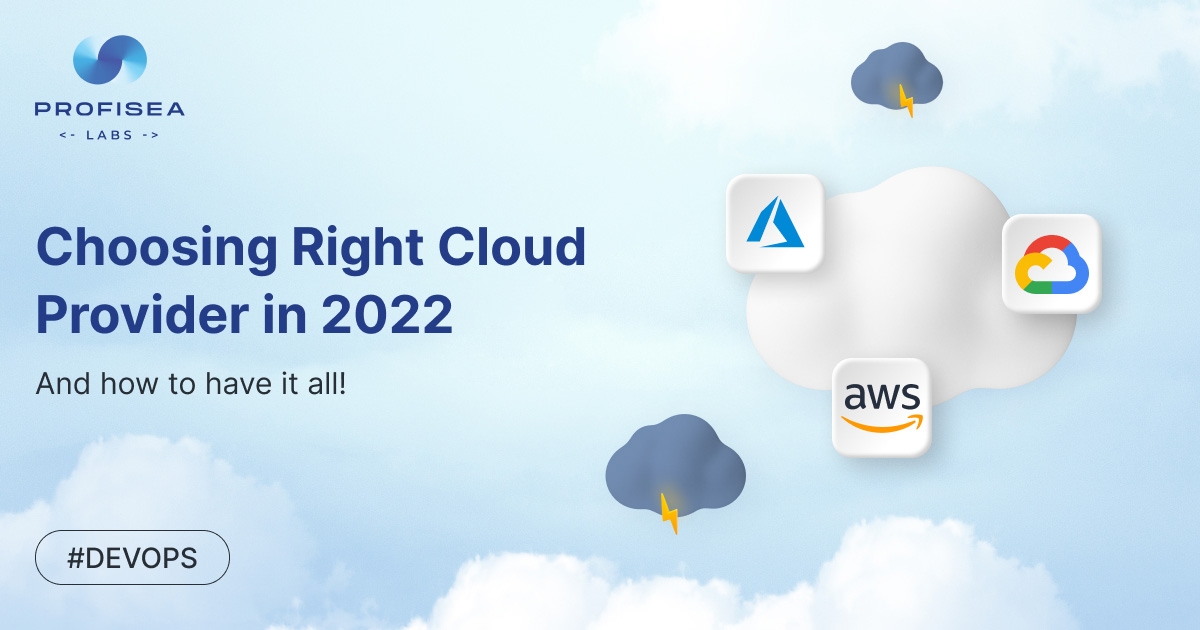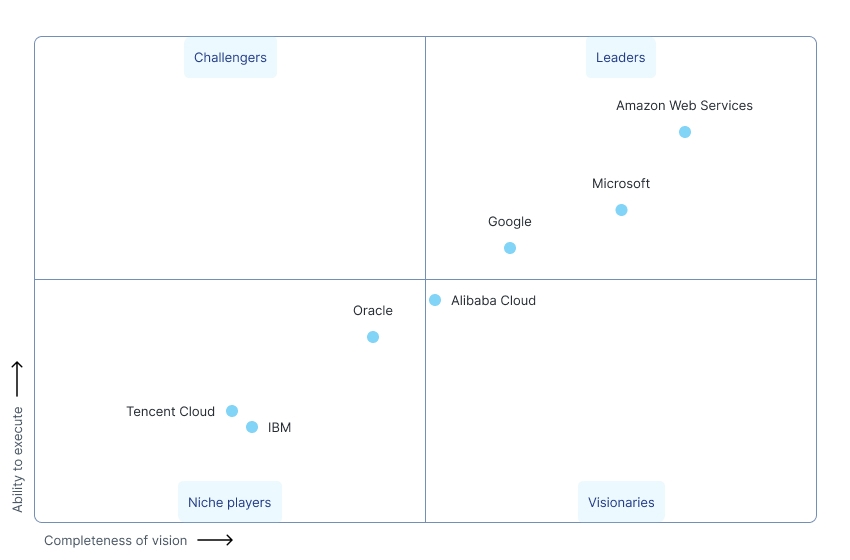
Choosing Right Cloud Provider in 2022 or How to Have It All
Cloud Computing is the most talked-about term phrase over the past years. Why? Because, as Sid Nag, VP at Gartner rightly said, events in recent years have enabled CIOs to overcome any hesitation to move mission-critical workloads from on-premises to the cloud. Even if it wasn’t a pandemic, the demand for data centers will still inevitably decline. The latest forecast from Gartner revealed that global end-user spending on public cloud services will grow 23.1% in 2021 to $ 332.3 billion, up from $ 270 billion in 2020 – public cloud services are booming. Software as a service (SaaS) remains the largest market segment and is projected to reach $ 122.6 billion in 2021 as demand for composable applications requires a different, so to say, sophisticated type of SaaS. Infrastructure as a Service (IaaS) and Desktop as a Service (DaaS) will see the peak boost in 2021, IaaS – 38.5% and DaaS – 67.7%, as CIOs face constant pressure to adopt and scale the infrastructure that supports the movement of complex workloads into the cloud and a great need for a hybrid environment. Given the global cloud computing market is expected to grow to $ 947.3 billion by 2026
(which is almost twice as much vis-a-vis 2021), global CSPs (cloud service providers) are rushing to bring their customers cost-effective and high-performing cloud solutions. But how do you decide which cloud provider is a good one, considering cloud services and offerings’ enormous sprawl? Which one is good for your organization’s specifics? Which one is more economical but effective at the time? Simply put, should you choose AWS, GCP, MS (Microsoft) Azure, or any other niche provider like Alibaba or Cloud Oracle? Or maybe you can have it all? Are you intrigued? Keep reading then!

Source: gartner.com
AWS, GCP, MS Azure, and a crew!
According to Gartner’s Magic Quadrant AWS, MS Azure, and GCP are undisputed leaders among cloud service providers. Rising stars like Alibaba, Cloud Oracle, Tencent Cloud, and IBM follow these three bosses in that particular order.

Source: Magic Quadrant for Cloud Infrastructure and Platform Services. Gartner. Inc
Gartner experts advocate AWS for its rich variety of services and targeting ever-larger portions of the cloud infrastructure supply chain which notably strengthens the long-term prospects for this cloud provider and gives it a competitive edge. Given AWS recently earned $ 59 billion, which appeared to be almost 55% of Amazon’s total revenue in 2021, the business picture looks pretty good, and, going forward, AWS will focus on trying to take over the supply
chain fields to hand over more cloud services to more customers.
MS Azure is growing 51% annually and has a wide-ranging set of capabilities that span the entire spectrum of enterprise IT needs: SaaS, PaaS, IaaS, powered with compelling capabilities including developer tools like Visual Studio and GitHub and a full table of public cloud services.
GCP is effective in almost all use cases and is gradually improving its core computing capabilities providing access to geographically diversified operations for big businesses as well as SMDOs and start-ups. Gartner experts claim that companies turn to GCP when choosing a strategic cloud service provider for the next time period of a few years. GCP can boast of a 54% annual revenue increase and an almost 60% reduction in operating as the 2021 second-quarter result.
| CSP | PROS | CONS |
|---|---|---|
| AWS |
|
|
| MS Azure |
|
|
| GCP |
|
|
| Oracle Cloud |
|
|
| Alibaba Cloud |
|
|
Here we come to the evergreen since the beginning of the cloud computing era question – How to choose the right cloud service provider? Frankly speaking, all mentioned cloud platforms are good enough. We only can name a couple of general growth zones for all of them: 1. cloud costs are too high; 2. lack of hybrid offerings; 3. almost all CSPs are poorly integrated with internal solutions. So, before you make this complex decision at first glance, you should
understand what features your organization needs and how much you are willing to pay for them. Just remember, you never start without a well-developed cloud migration and post-migration cost-optimization strategy. “What if I need different solutions from different CSPs?” – you might ask.
Multi-Cloud Platform – Excellent!
Multi-cloud architectures welcoming the public, private, and hybrid cloud services surely is a brilliant idea and wise investment strategy for many IT businesses. By strategically distributing your cloud management tasks across multiple vendors, adopting multiple clouds can help increase efficiency, capture economies of scale, and ensure sustainable performance for your cloud empire. Bearing in mind that the market’s expectation for the adoption of fully managed multi-cloud services is growing year after year, ProfiSea Labs’ experts designed a CloudOps platform to let the users visualize, govern, analyze, and optimize their multi-cloud infrastructure. Powered by artificial intelligence, ProfiSea Labs analyzes system usage and user behavior patterns and provides unique insights to help cut cloud costs and stay within the cloud budget.
ProfiSea Labs’ innovative approach is built around a visual representation of all the company’s cloud assets, coupled with AI-based well-rounded cost optimization automation that works together so customers can see all the wasted areas and make saving decisions quickly and safely. ProfiSea Labs already supports major cloud vendor Amazon Web Services (AWS), and support for Google Cloud, MS Azure, and other top CSPs is to follow shortly.
What does ProfiSea Labs do? ProfiSea Labs:
- Addresses the full spectrum of CloudOps challenges by introducing an innovative approach where visibility into cloud assets and superior cost optimization automation work together to enable customers to see all the losses and make
savings decisions quickly and securely. - Combines all cloud cost optimization best practices into one unique savings strategy to reduce wasted capacity on the cloud.
- Offers and manages AI-driven scheduling policies, reduces costs with patented seat management technology, and manages reservations with a smart suggestion.
- Helps users to visualize and save up to 90% with a unique AI-based smart scheduling strategy, spots control, and many other features.
- Provides explicit analytics and reporting. With ProfiSea Labs, analytics and reporting are done with a single click.
- Automates all SDLC processes related to DevOps, allowing DevOps engineers, FinOps experts, and IT managers to easily manage cloud costs and spend more time on creative and business tasks.
- Increases the productivity of experts. Teams free their hands from tedious manual work and mainly focus on creative tasks that are more valuable to the business.
ProfiSea Labs is winning the digital market and leaving other market players far behind since their cloud solutions are mostly first-generation and failed neck-and-neck evolving with cloud computing features. Plus, they are extremely costly and enterprise-oriented leaving SMB’s and startups face-to-face with unaddressed CloudOps challenges. As a new-generation solution, ProfiSea Labs transforms the cloud industry and makes efficient cloud management equally
accessible for small, medium, and large companies.
Final thoughts: Turn to hybrid multi-cloud platforms to have it all!
A multi-cloud approach is quite beneficial for IT businesses when they move critical infrastructure parts to the cloud. However, for a multi-cloud strategy to work companies need to make sure they get the best cloud management capabilities available. One of such state-of-art multi-cloud management platforms is ProfiSea Labs, which standardizes the hybrid multi-cloud infrastructure operations across your organization so you can do more work and perform better in less time. Thus, we will be happy to help if you have DevOps/CloudOps-related questions or decide to contact the perfect multi-cloud management platform provider, drop us a message.